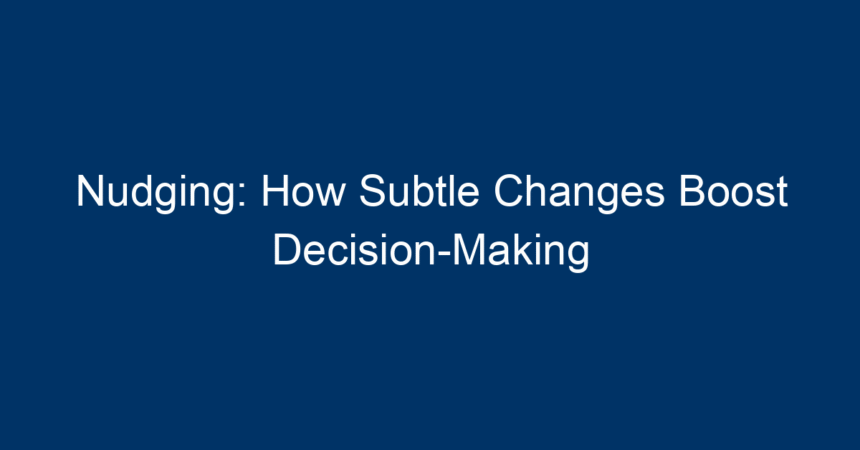In our daily lives, we encounter countless decisions, from what to eat for breakfast to larger financial choices. Often, these decisions are influenced by external factors without us even realizing it. This phenomenon is known as nudging, a concept rooted in behavioral economics that highlights how subtle changes in the environment can significantly impact our choices. In this article, we will delve deep into the mechanics of nudging, its applications in various sectors, and how you can leverage these insights to enhance decision-making in your personal and professional life.
What is Nudging?
At its core, nudging refers to the strategic design of environments to subtly guide individuals towards making certain choices while preserving their freedom to choose otherwise. This concept was popularized by Richard Thaler and Cass Sunstein in their groundbreaking book, Nudge: Improving Decisions About Health, Wealth, and Happiness. The essence of nudging lies in the understanding that humans are not always rational decision-makers; instead, our choices are often influenced by emotions, biases, and social pressures.
The Science Behind Nudging
Nudging is informed by principles from psychology and behavioral economics. Here are some key elements:
-
Cognitive Biases: Humans have various cognitive biases that affect decision-making. For instance, the status quo bias leads people to prefer things to stay the same rather than change, even if better options exist.
-
Framing Effect: How options are presented can significantly affect decisions. For example, stating that a product has a "90% success rate" can lead to higher acceptance than saying it has a "10% failure rate," despite the facts being identical.
- Social Norms: People often look to others when making decisions. Highlighting that a majority of peers have adopted a certain behavior can significantly encourage similar actions in individuals.
The Implementation of Nudging
Nudging can be tactfully implemented in various areas, including health, finance, education, and environmental conservation.
Health and Wellness
In healthcare, nudging can promote healthier lifestyle choices. For instance, providing smaller portion sizes in cafeterias or placing fruits at eye level in supermarkets can lead to better dietary choices. Hospitals have also used nudges, such as reminders for regular check-ups, to improve patient outcomes.
Financial Decisions
In the financial sector, nudging can significantly enhance saving rates. For example, automatically enrolling employees in retirement savings plans but allowing them the option to opt-out is a powerful nudge that has been shown to increase savings participation substantially.
Education
In educational settings, nudging can help improve student performance. Sending timely reminders about deadlines or providing insights into how a student’s performance compares to their peers can motivate them to engage more actively in their studies.
Environmental Sustainability
To encourage more environmentally-friendly choices, nudges can be used effectively. For example, making the default setting for printers double-sided can reduce paper usage significantly. Similarly, providing feedback on energy consumption can prompt individuals to alter their energy-use behaviors.
The Role of Choice Architecture
Choice architecture is an essential component of nudging, focusing on how choices are presented to individuals. A well-structured choice environment considers human psychology, making it easier for people to make decisions aligned with their values and goals.
Key Principles of Choice Architecture
-
Defaults: Setting beneficial options as the default can lead to greater uptake. For example, defaulting to renewable energy sources can particularly enhance adoption rates among consumers.
-
Salience: Highlighting critical information can direct attention and facilitate better decision-making. For example, using bright labels for healthier food options in restaurants increases their visibility.
-
Simplification: Reducing the complexity of choices can help individuals make decisions more easily. For instance, a simplified enrollment process for health insurance can lead to higher participation rates.
- Feedback: Providing immediate feedback helps individuals understand the consequences of their choices, leading to better decision-making over time.
Case Studies
To better understand the impact of nudging, consider these case studies:
-
The UK Energy Market: A study showed that consumers receiving information about their energy consumption and comparisons to their neighbors reduced their energy usage by up to 10%.
- Organ Donation: Countries with opt-out organ donation systems (where individuals are automatically enrolled unless they choose otherwise) have much higher donation rates than those with opt-in systems.
Designing Effective Nudges
Creating effective nudges requires a nuanced understanding of behavioral economics and a commitment to ethical design. Here are some strategies to consider:
Understand Your Audience
To design effective nudges, you must first understand the preferences, values, and behaviors of your target audience. Conduct surveys or focus groups to gather insights into what motivates them.
Test and Iterate
Implement nudges in small-scale pilot programs and assess their effectiveness before a broader rollout. Gather data, analyze results, and be willing to iterate based on feedback.
Maintain Transparency
While nudging aims to influence decision-making positively, it’s essential to maintain transparency to build trust. Clearly communicate the intent behind the nudges to your audience.
Balance Influence with Freedom
The power of nudging lies in its subtlety. While it’s essential to guide individuals toward beneficial choices, respecting their autonomy and keeping alternative options visible is crucial.
Conclusion: The Power of Nudging in Decision-Making
Nudging is a potent approach to enhancing decision-making in various aspects of life, from health choices to financial planning. By understanding the psychology behind this concept and leveraging effective choice architecture, individuals and organizations can create environments that facilitate better decisions while preserving personal freedom.
Actionable Insights
-
Incorporate Nudges in Daily Life: Whether it’s placing fruits and vegetables at the front of your fridge or setting savings as the default option for investments, small changes can lead to significant impacts.
-
Utilize Feedback Loops: Create systems where you receive regular feedback on your choices. Whether it’s tracking your health goals or budget spending, feedback encourages better decision-making.
-
Adopt Choice Architecture: If you’re a business leader or educator, analyze the choice frameworks you present and seek to improve them based on nudging principles.
- Educate Others: Spread awareness about nudging within your community. Understanding how decisions are influenced can empower individuals to make better choices.
By embracing nudging techniques, we not only improve our decision-making but also contribute to a healthier, wealthier, and more sustainable future.




